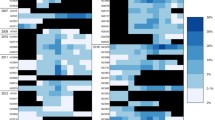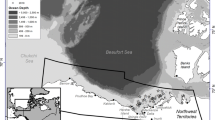Abstract
During aerial surveys in September 1987–2003, a total of 315 live polar bears were observed with 12 (3.8%) animals in open water, defined for purposes of this analysis as marine waters >2 km north of the Alaska Beaufort Sea coastline or associated barrier islands. No polar bear carcasses were observed. During aerial surveys in early September, 2004, 55 polar bears (Ursus maritimus) were seen, 51 were alive and of those 10 (19.9%) were in open water. In addition, four polar bear carcasses were seen floating in open water and had, presumably, drowned. Average distance from land and pack ice edge for live polar bears swimming in open water in 2004 (n=10) were 8.3±3.0 and 177.4±5.1 km, respectively. We speculate that mortalities due to offshore swimming during late-ice (or mild ice) years may be an important and unaccounted source of natural mortality given energetic demands placed on individual bears engaged in long-distance swimming. We further suggest that drowning-related deaths of polar bears may increase in the future if the observed trend of regression of pack ice and/or longer open water periods continues.


Similar content being viewed by others
References
Amstrup SC (2000) Polar bear. In: Truett JC, Johnson SR (eds) The natural history of an Arctic oil field: development and biota. Academic Press, San Diego, pp 133–157
Amstrup SC, Durner GM, Stirling I, Lunn NJ, Messier F (2000) Movements and distribution of polar bears in the Beaufort Sea. Can J Zool 78:948–966
Amstrup SC, McDonald TL, Stirling I (2001) Polar bears in the Beaufort Sea: a 30-year mark-recapture case history. J Agric Biol Environ Stat 6:221–234
Brower WA, Baldwin RG, Williams CN, Wise JL, Leslie LD (1988) Climatic atlas of the outer continental shelf waters and coastal regions of Alaska, vol III. Final report to U.S. Minerals Management Service, Alaska Outer Continental Shelf Region. OCS Study MMS 87–0013, 524pp
Brower CD, Carpenter A, Branigan ML, Calvert W, Evans T, Fischbach AS, Nagy JA, Schliebe S, Stirling I (2002) The polar bear management agreement for the southern Beaufort Sea: an evaluation of the first ten years of a unique conservation agreement. Arctic 55:362–372
Burns JJ, Shapiro LW, Fay FH (1981) Ice as marine mammal habitat in the Bering Sea. In: Hood DW, Calder JA (eds) The eastern Bering Sea shelf: oceanography and resources. Office of Marine Pollution Assessment, NOAA, pp 781–797
Chapman CF (1977) Piloting, seamanship and small boat handling. Hearst Books, New York, p 640
Clarke JT, Moore SE, Johnson MM (1993) Observations on beluga fall migration in the Alaskan Beaufort Sea, 1982–87, and northeastern Chukchi Sea, 1982–91. Rep Int Whaling Comm 43:387–396
Comiso JC (2002a) Correlation and trend studies of the sea-ice cover and surface temperatures in the Arctic. Ann Glaciol 34:420–428
Comiso JC (2002b) A rapidly declining perennial sea-ice cover in the Arctic. Geophys Res Lett 29:1956
Comiso JC (2003) Warming trends in the Arctic from clear-sky satellite observations. J Clim 16:3498–3510
Comiso JC (2005) Impact studies of a 2°C global warming on the Arctic sea ice cover. In: Rosentrater L (eds) Evidence and implications of dangerous climate change in the Arctic. World Wildlife Fund International Arctic Program, Oslo, Norway, pp 43–55
Derocher AE, Stirling I (1992) The population dynamics of polar bears in the western Hudson Bay. In: McCullough DR, Barrett RH (eds) Wildlife 2001: populations. Elsevier Applied Science, London, pp 1150–1159
Derocher AE, Andriashek D, Stirling I (1993) Terrestrial foraging by polar bears during the ice-free period in western Hudson Bay. Arctic 46:251–254
Derocher AE, Lunn NJ, Stirling I (2004) Polar bears in a warming climate. Integr Comp Biol 44:163–176
ESRI (2001) ArcGIS. Environmental Research Systems Research Institute, Inc., Redlands, California
Evans TJ, Fischbach A, Schliebe S, Manly BFJ, Kalxdorff S, York G (2003) Polar bear aerial survey in the eastern Chukchi Sea: a pilot study. Arctic 56:359–366
Ferguson SH, Taylor MK, Messier F (2000) Influence of sea ice dynamics on habitat selection by polar bears. Ecology 81:761–772
Gough WA, Cornwell AR, Tsuji LJS (2004) Trends in seasonal sea ice duration in southwestern Hudson Bay. Arctic 57:299–305
Hassol SJ (2004) ACIA-Impacts of a warming Arctic: Arctic climate impact assessment. Cambridge University Press, Oxford, p 146
Hoefler Consulting Group (2004) Nearshore Beaufort Sea meteorological monitoring and data synthesis project- third quarter 2004 data report. US Department of Interior, Minerals Management Service—unpublished report, 36pp (available from Minerals Management Service, 3801 Centerpoint Drive, Suite 500, Anchorage, Alaska)
Hurst RJ, Øritsland NA, Watts PD (1982) Body mass, temperature, and cost of walking in polar bears. Acta Physiol Scand 115:391–395
Labelle JC, Wise JL, Voelker RP, Schulze RH, Wohl GM (1983) Alaska marine ice atlas. Arctic Environmental Information Data Center, University of Alaska, Anchorage, p 302
McDonald LL, Garner GW, Robertson DG (1999) Comparison of aerial survey procedures for estimating polar bear density: results of pilot studies in northern Alaska. In: Garner GW, Amstrup SC, Laake JL, Manly BFJ, McDonald LL, Robertson DG (eds) Marine mammal survey and assessment methods. A.A. Balkema, Rotterdam, pp 37–51
Monnett C, Treacy SD (2005) Aerial surveys of endangered whales in the Beaufort Sea, fall 2002–2004. OCS Study, MMS 2005–037, 153pp
Moore SE (2000). Variability of cetacean distribution and habitat selection in the Alaskan Arctic, autumn 1982–91. Arctic 53:448–460
NAVY/NOAA (2002) United States Navy—National Oceanographic and Atmospheric Administration Joint Ice Center: Seasonal Outlook Western Arctic Ice, 2002. Prepared by Naval Polar Oceanography Center for Naval Oceanography Command. Available on-line at http://www.natice.noaa.gov/
Norris S, Rosentrater L, Eid PM (2002) Polar bears at risk: a status report. World Wildlife Fund International Arctic Programme, Oslo, p 27
Norton D, Weller G (1984) The Beaufort Sea: background, history, and perspective. In: Barnes P, Schell D, Reimnitz E (eds) The Alaskan Beaufort Sea: ecosystems and environments. Academic Press, San Diego, p 465
Øritsland NA (1969) Deep body temperatures of swimming and walking polar bears. J Mammal 50:380–382
Ramsay MA, Stirling I (1988) Reproductive biology of female polar bears (Ursus maritimus). J Zool 214:601–634
Rothrock DA, Yu Y, Maykut GA (1999) Thinning of the Arctic sea-ice cover. Geophys Res Lett 26:3469–3472
Serreze MC, Barry RG (2005) The Arctic climate system. Cambridge University Press, New York, p 424
Serreze MC, Walsh JE, Chapin FSI, Osterkamp T, Dyurgerov M, Romanovsky V (2000) Observational evidence of recent change in the northern high-latitude environment. Clim Change 46:159–207
Skinner WR, Jefferies RL, Carleton TJ, Rockwell RF, Abraham KF (1998) Prediction of reproductive success and failure in lesser snow geese based on early season climatic variables. Global Change Biol 4:3–16
SPSS Inc (2001) SPSS for Windows, Release 10.1. Chicago, Illinois, USA
Stirling I (1988) Attraction of polar bears Ursus maritimus to offshore drilling sites in the eastern Beaufort Sea. Polar Rec 24:1–8
Stirling I (1990) Polar bears and oil: ecological perspectives. In: Geraci JR St. Aubin DJ (eds) Sea mammals and oil: confronting the risks. Academic Press, San Diego, pp 223–234
Stirling I (2002) Polar bears and seals in the eastern Beaufort Sea and Amundsen Gulf: a synthesis of population trends and ecological relationships over tree decades. Arctic 55:59–76
Stirling I, Andriashek D, Calvert W (1993) Habitat preferences of polar bears in the western Canadian Arctic in late winter and spring. Polar Rec 29:13–24
Stirling I, Derocher AE (1993) Possible impacts of climatic warming on polar bears. Arctic 46:240–245
Stirling I, Lunn N (1997) Environmental fluctuations in Arctic marine ecosystems as reflected by variability in reproduction of polar bears and ringed seals. In: Woodin SJ, Marquiss M (eds) Ecology of Arctic environments, Special Publication No. 13. British Ecological Society, pp 167–180
Stirling I, Lunn NJ, Iacozza J (1999) Long-term trends in the population ecology of polar bears in western Hudson Bay in relation to climatic change. Arctic 52:294–306
Stroeve JC, Serreze MC, Fetterer F, Arbetter T, Meier W, Maslanik J, Knowles, K (2004) Tracking the Arctic’s shrinking ice cover: another extreme September minimum in 2004. Geophys Res Lett 32:L04501 (DOI: 10.1029/2004GL021810)
Taylor MK, DeMaster DP, Bunnell FL, Schweinsburg RE (1987) Modelling the sustainable harvest of female polar bears. J Wildl Manage 51:811–820
Treacy SD (2002) Aerial surveys of endangered whales in the Beaufort Sea, fall 2001. OCS Study, MMS 2002–14, 111pp
Acknowledgements
We thank Steve Treacy who was research manager for most of the project’s duration (1987–2003). We thank Cleve Cowles who has been project supervisor since its inception. We thank the numerous personnel from the Minerals Management Service and other agencies who participated in BWASP as team leaders, observers, data recorders or in other capacities during this project. We greatly appreciate the services, knowledge and skills provided by staff, and pilots of ERA, Inc. who participated in the surveys, as well as support from the Department of Interior, Office of Aircraft Services, Anchorage. Project data collection and field analysis programs used throughout were designed by John Bennett, John Dunlap and Tom Murrell. Matt Heller assisted with data management and figure preparation. Warren Horowitz managed contracts that provided weather from the Endicott Weather Station. We also acknowledge the National Ice Center for providing data on sea ice conditions. We thank Craig Perham and Susanne Miller for sharing data on observations of bears on land along the Beaufort Sea coastline. We thank Ian Stirling and Richard Shideler for sharing observations of polar bears suffering from fatigue upon coming ashore following open-water swimming. This paper benefited greatly from reviews by, and discussions with, Andrew Derocher, Lisa Rotterman, Richard Shideler, Ian Stirling and Cleveland Cowles. This paper was improved by useful comments from Rolf Gradinger and three anonymous reviewers. Funding for BWASP surveys was provided by the U.S. Minerals Management Service, Alaska Outer Continental Shelf Region. The findings and conclusions in this paper are those of the authors and do not necessarily represent the views of the funding agency. Any mention of trade names is coincidental and does not represent endorsement by the government.
Author information
Authors and Affiliations
Corresponding author
Rights and permissions
About this article
Cite this article
Monnett, C., Gleason, J.S. Observations of mortality associated with extended open-water swimming by polar bears in the Alaskan Beaufort Sea. Polar Biol 29, 681–687 (2006). https://doi.org/10.1007/s00300-005-0105-2
Received:
Revised:
Accepted:
Published:
Issue Date:
DOI: https://doi.org/10.1007/s00300-005-0105-2




